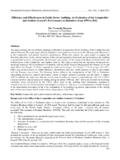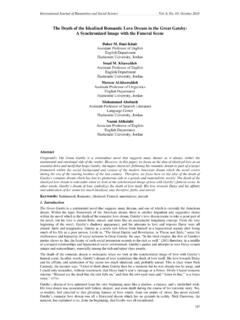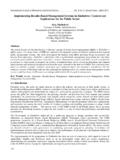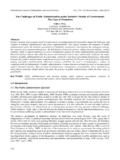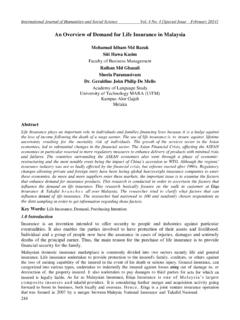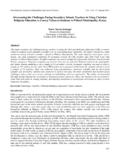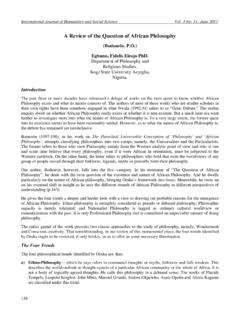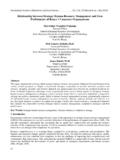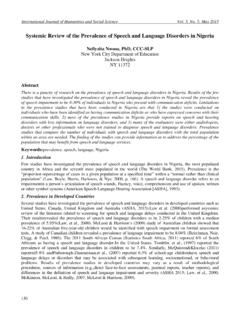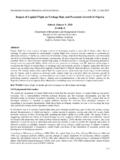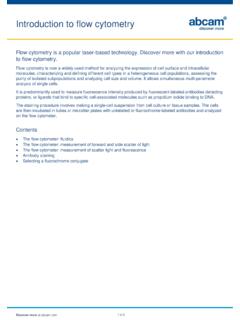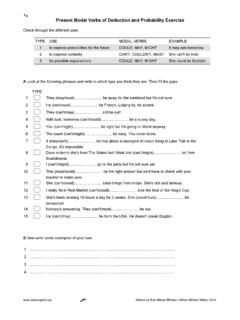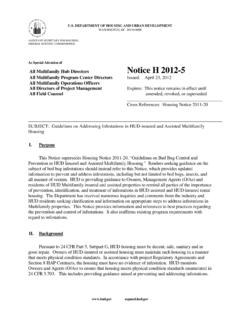Transcription of The Impact of Leadership on Teachers’ Effectiveness
1 International Journal of Humanities and Social Science Vol. 4, No. 7(1); May 2014 34 The Impact of Leadership on Teachers Effectiveness Konsolas Emmanouil Assistant Professor Department of Pre-School Education and Educational Design University of the Aegean Greece Anastasiou Osia MA Primary School teacher Institute of Educational Policy Greece Loukeri Paraskevi-Ioanna University of Southampton School of Education UK Abstract The continuous and intensive socio-economic changes have created the need of restructuring educational practices as well as the structures of the schools. New challenges have been introduced aiming not only to improve the educational outcomes but also to achieve the adaptation to the new community needs. In the educational arena, teacher is the mediator, the person that expresses the evolutions and transforms them to knowledge.
2 This paper reveals the involvement of educational Leader in the teacher s educational process. Leadership policy is a crucial factor for the teacher s Effectiveness . Some practices, in relation with Leadership policy, are proved that contribute to teacher s empowerment. Keywords: Impact , Instructional Leadership , Transformational Leadership , Practices, Effectiveness 1. Introduction The idea of organizing schools as learning organizations where the practices allow for continuous learning is rapidly and steadily considered as the mediator for achieving school improvement (Silins and Mulford, 2002). The school is gradually transformed into a learning organization which needs to refresh the processes involving its current and future needs (Huber, 2004). A great deal of research on factors promoting teacher Effectiveness has been conducted by educational scholars. Leadership practices seem to have quite positive effects on teacher s lifelong professional development in the school context (Flores 2007) because they have the potential to empower teachers towards a commitment to change and enhance their learning in school organization (Bogler, 2001; Fullan, 2002; Day et al, 2001).
3 Our purpose in this paper is to give a brief description of the main Leadership practices that contribute to teachers Effectiveness . In the sections that follow, we first provide definitions of the two Leadership Models (Instructional Leadership and Transformational Leadership ). Following that, we present Leadership practices that enhance teacher Effectiveness . We then offer general conclusions that came out from six studies that have attempted to reveal the Impact of Leadership on teacher s Effectiveness . 2. Leadership Models Effective Leadership has a key role in motivating teachers towards individual and shared learning, a factor which is considered to be quite important for school Effectiveness to be achieved (Leithwood & Jantzi, 2000). Center for Promoting Ideas, USA 35 Consequently, it becomes clear that Leadership is the mediator which has the authority to develop and empower teachers in the quest of school Effectiveness (Huber, 2004).
4 Over the past 25 years there are several different theoretical models concerning the educational Leadership . However, two basic models have dominated: the instructional Leadership and the transformational Leadership (Hallinger, 2003). Each one of these models considers the school principal s role and its characteristics from a different perspective. The idea of the educational instructional Leadership which was introduced during the early 1980s describes a principal who wants to manage, supervise and develop curriculum and instruction in the school context (Bamburg & Andrews, 1990). Instructional leaders usually aim to school improvement having a strong goal orientation (Hallinger, 2003) but at the same time they construct an academic pressure because of indicating high expectations from the teachers (Hallinger & Murphy, 1986). According to Hallinger (2000), an instructional leader specifies the school s aims, organizes the instructional program in order to achieve these goals and tries to promote learning by constructing the appropriate climate.
5 Several additional practices are also applied by the principal in the school setting. For example, the communication between the leader and the teaching staff seems to be quite important for the specific educational and learning goals to be extensively known and supported by the total school community. Additionally, the principal should manage the instruction procedure on the whole and supervise the student s progress. An instructional principal tries also to create a positive learning environment by supporting the professional development, sharing his vision and providing strong motivations and inspirations for learning to the teaching staff (Hallinger, 2000). Instructional Leadership has adopted a top-down approach. On the other side, Transformational Leadership seems to have a bottom-up focus. Specifically, it does not come exclusively from the principal; the teaching staff participate too (Leithwood & Jantzi, 2000) and teachers needs and views are usually taken into consideration.
6 For this reason transformational model of Leadership is thought to be a kind of shared or distributed Leadership which, based on bottom-up participation, aims to striking educational change (Day et al, 2001). Moreover, contrary to the instructional Leadership which is established on direct management and supervision of teaching (Leitner, 1994), transformational principals enforce teachers capacity and engage them in collaboratively learning. This type of head teachers attempts to link the individual goals with the organizational ones and as a consequence creates the climate where the educators have the chance to be self-motivated towards the achievement of school Effectiveness , without the principal s guidance being necessary (Hallinger, 2003). 3. Leadership Practices Enhancing teacher Effectiveness teacher : Individual Aims or School Orientation Aims? Leadership , in whichever model it embraces, has as central goal to ensure and maintain the school improvement which has to do with the quality of teaching; the most influential factor of students achievement.
7 It is obvious though that the quality and the Effectiveness of Leadership is understood and evaluated in correspondence with regards to teachers motivation and Effectiveness (Fullan, 2001). According to recent research, one of the main Leadership practices has to do with the teacher s empowerment which is strongly related to the central goal of the school; students learning. The improvement of the employees performance is a significantly important aim which the leader tries to achieve through several actions taking into consideration individuals beliefs, values, motivations and skills (Leithwood, 2006). Structuring a specific vision and giving directions, they provide teachers with a strong motivation to improve their performance. In particular, setting a shared purpose that clarifies the roles, the objectives and the desired expectations from the teachers performance they enhance teachers Effectiveness in the classroom.
8 An additional managerial strategy is the personal support provided by the head teacher and also the construction of the appropriate environment for accomplishing personal and organizational aims. Moreover, it is the principal s responsibility to build that kind of work conditions which would allow for productive and creative relationships between the teachers and the whole community, enforcing in this way the professional development of the teaching staff. Also, the leader can provide opportunities for teachers learning by organizing and managing several programs concerning their professional development or by offering individual mentoring to them (Leithwood & Jantzi, 2006). Such Leadership practices produce supportive working conditions to motivate and influence the teaching staff. Going through recent evidence it could be stated that leaders are also able to determine teachers emotions which are considered to be influential to their motivation and Effectiveness , such as: sense of efficacy, job satisfaction and anxiety (Leithwood & Jantzi, 2006).
9 International Journal of Humanities and Social Science Vol. 4, No. 7(1); May 2014 36 A teacher to be motivated should be helped to evaluate and recognize the need to change his/her perceptions towards a specific direction-action. So, motivation could be considered as the interaction between individual aims and the goal-orientation of the school (Ford, 1992). For this reason, a leader should adopt strategies in order to motivate teachers and coordinate their personal aims with the school ones. The sense of capacity is usually a strong motivating feeling which increases the amount of effort paid, aiming to achieve the common goal. Some of the Leadership strategies which could increase the teachers capacity and as a consequence their motivation is the positive and supporting feedback, the experience shared with the teaching staff and the communication in order to explain in details the aims and the actions that should be applied (Leithwood & Jantzi, 2006).
10 Positive emotions also, in correspondence with the achievement of a personal goal, seem to have motivational value which could be empowered if the principal expresses his confidence concerning the success attained through positive feedback (Leithwood & Jantzi, 2006). Having in mind that the Effectiveness of employees is highly dependent on whether they are satisfied in the working settings or not, leaders should give great attention to raise teachers job satisfaction (Heller, Clay and Perkins, 1993). According to Locke (1976), job satisfaction is defined as a positive emotional situation which derives from acceptance of one s job and experience. According to studies conducted, there are several Leadership activities, such as initiating structure, which deeply influence the factor of job satisfaction (Nguni, Sleegers and Denessen 2006). The more autonomous the teacher is the more satisfied he/she feels in the job settings (Hall, Pearson and Caroll, 1992).
